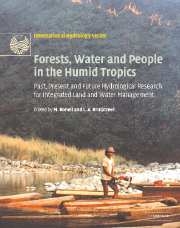 Forests, Water and People in the Humid Tropics
Forests, Water and People in the Humid Tropics from Part IV - New methods for evaluating effects of land-use change
Published online by Cambridge University Press: 12 January 2010
INTRODUCTION
The existence of a large number of catchment hydrology models, evident from even a cursory glance at the literature, is likely to cause trepidation or confusion for even expert modellers, let alone practitioners of hydrology who merely require something ‘off the shelf’ which they can use with confidence. Typically, available catchment models often come with exaggerated claims for the breadth of their applicability, and little or no in-depth discussion of their inherent assumptions and consequent limitations. Two questions will therefore be addressed in this chapter:
How can an appropriate model for my catchment be chosen, given an intended application? and
How can an appropriate model be constructed (or an existing model be modified) if none exists at present?
There would appear to be several reasons for the present wide range of models, including:
a diverse range of catchments and purposes (for example, forecasting or regulatory support) which in turn implies interest in many different kinds of processes;
availability of different levels of information or data quantity and quality; and
the fact that catchments are complex systems, having a huge number of potentially significant processes, and consequently ‘emergent behaviour’ (defined later on) which is not evidently a simple sum of the component parts.
Taken together, these three factors imply that to represent catchment behaviour efficiently, much of what is deemed to be of secondary importance must inevitably be either ignored or greatly simplified by using specific assumptions.
To save this book to your Kindle, first ensure [email protected] is added to your Approved Personal Document E-mail List under your Personal Document Settings on the Manage Your Content and Devices page of your Amazon account. Then enter the ‘name’ part of your Kindle email address below. Find out more about saving to your Kindle.
Note you can select to save to either the @free.kindle.com or @kindle.com variations. ‘@free.kindle.com’ emails are free but can only be saved to your device when it is connected to wi-fi. ‘@kindle.com’ emails can be delivered even when you are not connected to wi-fi, but note that service fees apply.
Find out more about the Kindle Personal Document Service.
To save content items to your account, please confirm that you agree to abide by our usage policies. If this is the first time you use this feature, you will be asked to authorise Cambridge Core to connect with your account. Find out more about saving content to Dropbox.
To save content items to your account, please confirm that you agree to abide by our usage policies. If this is the first time you use this feature, you will be asked to authorise Cambridge Core to connect with your account. Find out more about saving content to Google Drive.